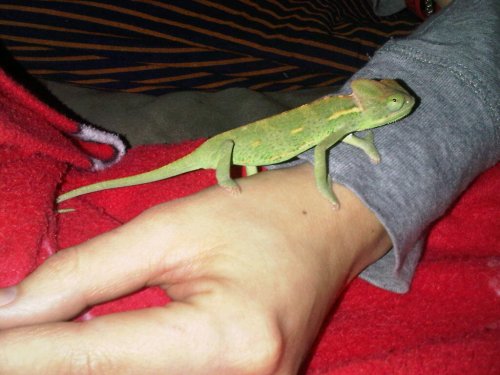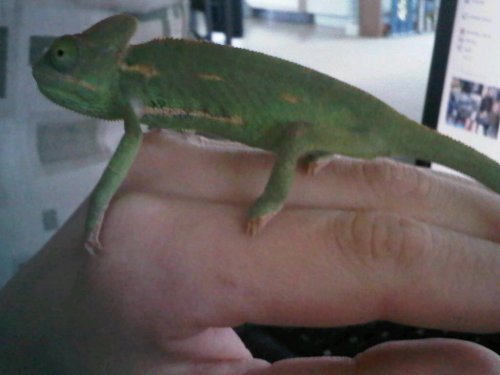Navigation
Install the app
How to install the app on iOS
Follow along with the video below to see how to install our site as a web app on your home screen.
Note: This feature may not be available in some browsers.
More options
You are using an out of date browser. It may not display this or other websites correctly.
You should upgrade or use an alternative browser.
You should upgrade or use an alternative browser.
what kind of chameleon do i have?
- Thread starter joeym39
- Start date
VeiledChams
Avid Member
Veiled Cham
Julirs
New Member
Pet stores usually are not-but you are in the right place. The essentials for a Veiled go something like this:
Screen or mesh cage
UVB linear tube-most recommended Zoomed Reptisun 5.0 linear flourescent tube-this is essential to cham keeping.
Basking lamp-usually a clamp lamp with a 60-75 watt bulb to keep as basking spot of 85-90 depending on the sex of your cham.
DIGITAL THERMOMETER-very essential to know what your temps are.
Vines and live (or a combo of live and fake plants) for your cham to climb on. Pothos, Schefflera and Ficus are great cham plants.
Supplements-a calcium with no D3 that you will use lightly on most feeders, a calcium with D3 that you will use 2 times monthly, and a multivite like Reptivite or Herptivite that you will use once a month.
Well gutloaded feeders-crickets, supers, roaches-gutloaded with dark leafy greens like Kale and Collards, sweet potatoes, carrots, fruits, grains, etc.
Screen or mesh cage
UVB linear tube-most recommended Zoomed Reptisun 5.0 linear flourescent tube-this is essential to cham keeping.
Basking lamp-usually a clamp lamp with a 60-75 watt bulb to keep as basking spot of 85-90 depending on the sex of your cham.
DIGITAL THERMOMETER-very essential to know what your temps are.
Vines and live (or a combo of live and fake plants) for your cham to climb on. Pothos, Schefflera and Ficus are great cham plants.
Supplements-a calcium with no D3 that you will use lightly on most feeders, a calcium with D3 that you will use 2 times monthly, and a multivite like Reptivite or Herptivite that you will use once a month.
Well gutloaded feeders-crickets, supers, roaches-gutloaded with dark leafy greens like Kale and Collards, sweet potatoes, carrots, fruits, grains, etc.
Chase
Chameleon Enthusiast
what do u think
Picture is kind of blurry, but I will say female. I can't really see a spur though.
LPR08
Julirs
New Member
Depends on what you mean by changing colors. They do not change to match their environment as is popularly thought. They will get dark when they are cold, lighter when they are hot, or can display different colors when they see a mate or rival. If you do in fact have a female she will not get as colorful as males will.
Last edited:
Welcome to the forum...and the world of chameleons!
Here's some information that you might find helpful....
Appropriate cage temperatures aid in digestion and thus play a part indirectly in nutrient absorption. Temperatures needed can vary with the species and age. For hatchling panthers I keep the temperature in the warmest area in the low 80's. For older panthers I keep it in the mid to high 80's for the most part.
Exposure to UVB from either direct sunlight or a proper UVB light allows the chameleon to produce D3 so that it can use the calcium in its system to make/keep the bones strong and be used in other systems in the chameleon as well. The UVB should not pass through glass or plastic no matter whether its from the sun or the UVB light. The most often recommended UVB light is the long linear fluorescent Repti-sun 5.0 tube light. Some of the compacts, spirals and tube lights have caused health issues, but so far there have been no bad reports against this one.
Since many of the feeder insects have a poor ratio of calcium to phosphorus in them, its important to dust the insects just before you feed them to the chameleon at most feedings with a phos.-free calcium powder to help make up for it. (I use Rep-cal phosphorus-free calcium).
If you also dust twice a month with a phos.-free calcium/D3 powder it will ensure that your chameleon gets some D3 without overdoing it. It leaves the chameleon to produce the rest of what it needs through its exposure to the UVB light. D3 from supplements can build up in the system but D3 produced from exposure to UVB shouldn't as long as the chameleon can move in and out of it. (I use Rep-cal phos.-free calcium/D3).
Dusting twice a month as well with a vitamin powder that contains a beta carotene (prOformed) source of vitamin A will ensure that the chameleon gets some vitamins without the danger of overdosing the vitamin A. PrEformed sources of vitamin A can build up in the system and may prevent the D3 from doing its job and push the chameleon towards MBD. However, there is controversy as to whether all/any chameleons can convert the beta carotene and so some people give some prEformed vitamin A once in a while. (I use herptivite.)
Gutloading/feeding the insects well helps to provide what the chameleon needs. I gutload crickets, roaches, locusts, superworms, etc. with an assortment of greens (dandelions, kale, collards, endive, escarole, mustard greens, etc.) and veggies (carrots, squash, sweet potato, sweet red pepper, zucchini, etc.)
Calcium, phos., D3 and vitamin A are important players in bone health and other systems in the chameleon (muscles, etc.) and they need to be in balance. When trying to balance them, you need to look at the supplements, what you feed the insects and what you feed the chameleon.
(If you have a female...once a female is sexually mature it can produce eggs without being mated so its important to provide an appropriate place in the cage for it to dig in to show you when it needs to lay eggs. An opaque container at least 12" deep x 12" x 8" filled with moistened washed playsand will do.)
Here are some good sites for you to read...
http://chameleonnews.com/07FebWheelock.html
http://web.archive.org/web/200605020...Vitamin.A.html
http://web.archive.org/web/200406080...d.Calcium.html
http://www.uvguide.co.uk/
http://raisingkittytheveiledchameleon.blogspot.com/
http://web.archive.org/web/200601140...ww.adcham.com/
If you can't access the sites above that have the word "archive" in you can do it through the WayBackMachine.
Here's some information that you might find helpful....
Appropriate cage temperatures aid in digestion and thus play a part indirectly in nutrient absorption. Temperatures needed can vary with the species and age. For hatchling panthers I keep the temperature in the warmest area in the low 80's. For older panthers I keep it in the mid to high 80's for the most part.
Exposure to UVB from either direct sunlight or a proper UVB light allows the chameleon to produce D3 so that it can use the calcium in its system to make/keep the bones strong and be used in other systems in the chameleon as well. The UVB should not pass through glass or plastic no matter whether its from the sun or the UVB light. The most often recommended UVB light is the long linear fluorescent Repti-sun 5.0 tube light. Some of the compacts, spirals and tube lights have caused health issues, but so far there have been no bad reports against this one.
Since many of the feeder insects have a poor ratio of calcium to phosphorus in them, its important to dust the insects just before you feed them to the chameleon at most feedings with a phos.-free calcium powder to help make up for it. (I use Rep-cal phosphorus-free calcium).
If you also dust twice a month with a phos.-free calcium/D3 powder it will ensure that your chameleon gets some D3 without overdoing it. It leaves the chameleon to produce the rest of what it needs through its exposure to the UVB light. D3 from supplements can build up in the system but D3 produced from exposure to UVB shouldn't as long as the chameleon can move in and out of it. (I use Rep-cal phos.-free calcium/D3).
Dusting twice a month as well with a vitamin powder that contains a beta carotene (prOformed) source of vitamin A will ensure that the chameleon gets some vitamins without the danger of overdosing the vitamin A. PrEformed sources of vitamin A can build up in the system and may prevent the D3 from doing its job and push the chameleon towards MBD. However, there is controversy as to whether all/any chameleons can convert the beta carotene and so some people give some prEformed vitamin A once in a while. (I use herptivite.)
Gutloading/feeding the insects well helps to provide what the chameleon needs. I gutload crickets, roaches, locusts, superworms, etc. with an assortment of greens (dandelions, kale, collards, endive, escarole, mustard greens, etc.) and veggies (carrots, squash, sweet potato, sweet red pepper, zucchini, etc.)
Calcium, phos., D3 and vitamin A are important players in bone health and other systems in the chameleon (muscles, etc.) and they need to be in balance. When trying to balance them, you need to look at the supplements, what you feed the insects and what you feed the chameleon.
(If you have a female...once a female is sexually mature it can produce eggs without being mated so its important to provide an appropriate place in the cage for it to dig in to show you when it needs to lay eggs. An opaque container at least 12" deep x 12" x 8" filled with moistened washed playsand will do.)
Here are some good sites for you to read...
http://chameleonnews.com/07FebWheelock.html
http://web.archive.org/web/200605020...Vitamin.A.html
http://web.archive.org/web/200406080...d.Calcium.html
http://www.uvguide.co.uk/
http://raisingkittytheveiledchameleon.blogspot.com/
http://web.archive.org/web/200601140...ww.adcham.com/
If you can't access the sites above that have the word "archive" in you can do it through the WayBackMachine.
Similar threads
- Replies
- 89
- Views
- 4K
- Replies
- 3
- Views
- 298






